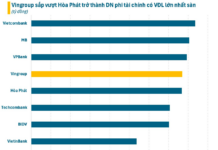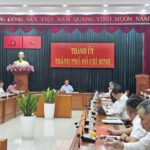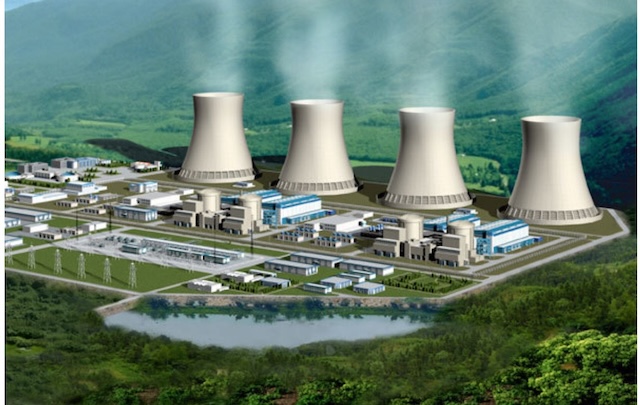
|
Artist’s impression of the Ninh Thuan Nuclear Power Project in 2016 – Archive Photo |
The Ninh Thuan Nuclear Power Project was first approved by the National Assembly in 2009, with a total capacity of 4,000 MW, divided into two plants on an area of 1,642 hectares. However, in 2016, the National Assembly resolved to temporarily halt the project due to various objective factors.
On November 25, 2024, the 13th Conference of the Central Executive Committee of the Party unanimously agreed on the policy to restart the Ninh Thuan Nuclear Power Project and continue researching Vietnam’s nuclear power program.
At the closing session on November 30, 2024, the National Assembly passed a resolution of the 8th session of the 15th National Assembly, which included consent to continue the investment policy for the Ninh Thuan Nuclear Power Project. Previously, the amended Law on Electricity, which stipulates some policies for the development of nuclear power, was also passed by the National Assembly, providing a legal basis for the realization of this policy.
On December 5, General Secretary To Lam inspected the site of the Ninh Thuan Nuclear Power Plant 1 and requested thorough preparation for the restart of the nuclear power project. A day earlier, at a meeting on legal issues, the government also considered a proposal to build the amended Atomic Energy Law.
It can be said that Vietnam has overcome its previous hesitancy towards this sustainable and reasonably priced energy source. In reality, for Vietnam, this is a necessary choice that meets the practical demands of the economy.
Solving the Energy Equation
Looking back at the history of nuclear power, since the first commercial nuclear energy was born in the 1950s and 1960s, governments worldwide have been captivated by its infinite potential. Nuclear reactors can harness and control the immense power of atomic fission, turning them into a plentiful and inexpensive energy source. Each kilogram of uranium can generate 20,000 times more energy than the same weight of coal, making nuclear power the ideal energy source for a future free from power shortages.
In August 2024, the International Atomic Energy Agency (IAEA) released the latest data on nuclear energy and operating experience in 2023, reflecting an important transition phase for this clean energy technology.
According to data from the IAEA’s Power Reactor Information System (PRIS), nuclear energy still contributes nearly 10% of global electricity production and accounts for a quarter of low-emission electricity generation.
In 2023, the United States continued to lead in nuclear power production, followed by China and France. Notably, China stood out by starting the construction of five new reactors, affirming its leading position in this field.
At the COP28 Climate Change Conference in December 2023, 198 nations called for accelerating the deployment of low-emission energy technologies, including nuclear power, to achieve the goal of net-zero emissions by 2050. More than 20 countries pledged to triple global nuclear power capacity, marking a strong development trend for the next decade.
As of the end of August 2024, there were 415 nuclear power reactors in operation worldwide, with a total installed capacity of about 373,735 MW, and 62 reactors under construction with a total capacity of about 64,971 MW. Currently, 32 countries own and operate nuclear power plants, and about 20 other nations are considering developing nuclear power to meet energy needs and fulfill climate commitments.
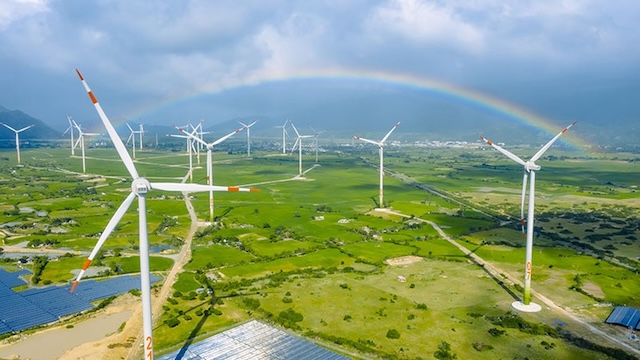
|
Although solar and wind power are expected to be green energy sources in the future, their unstable nature and dependence on natural conditions limit their contribution to the power grid. |
In Vietnam, according to the Power Development Plan VIII, by 2030, Vietnam will need 150,000 MW of power capacity, while this figure is expected to increase to about 490,000 – 573,000 MW by 2050. With an electricity growth rate of about 10% per year, Vietnam must seek a stable and reliable energy source.
While solar and wind power are anticipated to be future green energy sources, their unstable nature and dependence on natural conditions limit their contribution to the power grid. Meanwhile, coal-fired power plants face significant challenges in net-zero emission commitments. Therefore, nuclear power emerges as a strategic choice.
On October 26, 2024, at the group meeting of the 15th National Assembly’s 8th session, General Secretary To Lam raised the issue of “How to ensure sufficient energy supply for development?”. The General Secretary mentioned the year 2045: “Wind and solar power have their advantages and disadvantages. So, what should we do to ensure sufficient electricity by 2045? We must develop nuclear power, as the world is also doing.”
According to the General Secretary, “We had a policy before, but for some reasons, we temporarily halted it. However, the recent 10th Central Committee Conference agreed to restart the project and conduct research on this issue to seek the National Assembly’s opinion.”
“We must be very proactive. We cannot afford to wait for years for orientation, site surveys, land clearance, and technology selection. Time does not allow for such delays. We must act quickly and synchronously,” the General Secretary emphasized.
Urgent Need for a Power-Secure Economy
From the industry’s perspective, Minister of Industry and Trade Nguyen Hong Dien stated that the Ministry of Industry and Trade has advised the government on the necessity of developing nuclear power. At the 26th Conference of the Parties to the United Nations Framework Convention on Climate Change (COP26), countries committed to developing clean energy sources (solar and wind power). However, to efficiently utilize these renewable energy sources, a stable baseload power source is essential.
“Currently, baseload power sources include coal-fired and hydroelectric power plants. However, there are no longer conditions to develop coal-fired power, and there is limited potential for hydroelectric power. Meanwhile, we need to fulfill our commitments made at COP26, and developing nuclear power is an inevitable trend that many countries are pursuing,” the Minister explained.
The head of the Ministry of Industry and Trade affirmed, “Ninh Thuan is the location that has been carefully studied by partners and relevant ministries and sectors for a long time, and it is the most suitable place to develop nuclear power.”
Analyzing the urgency of restarting the Ninh Thuan Nuclear Power Project, Associate Professor Dr. Tran Van Binh, from the Institute of Economics and Management (Hanoi University of Science and Technology), stated, “If we do not develop nuclear power, we will not be able to meet the increasing energy demand. Nuclear power plants will replace coal-fired power plants, significantly reducing greenhouse gas emissions.”
|
“Nuclear power is a baseload, green, and sustainable energy source. Nuclear power is receiving increasing attention and continued development worldwide. While there have been some accidents involving nuclear power plants in history, the probability of such incidents is extremely low” – General Secretary To Lam stated during a working session with the Standing Committee of the Ninh Thuan Provincial Party Committee regarding the implementation of the Nuclear Power Project. |
From the perspective of Ninh Thuan province, Mr. Tran Quoc Nam, Chairman of the People’s Committee of Ninh Thuan province and Head of the Provincial Delegation of the National Assembly, shared that since the suspension of the investment policy for the Ninh Thuan Nuclear Power Project eight years ago, the people in the project area have been awaiting stable production and livelihood. When they heard that the Central Committee and the National Assembly decided to continue investing in the Ninh Thuan Nuclear Power Project, the people in the project area and Ninh Thuan voters expressed their agreement, trust, and compliance with the decisions, guidelines, and leadership of the Party.
“It is a great honor for the Party Committee and the people of Ninh Thuan province that the Central Committee and the National Assembly decided to restart the project in the context of the need to ensure sufficient energy supply, especially clean energy, to meet the economic development requirements of the country in the future in a more sustainable way,” said Mr. Tran Quoc Nam.
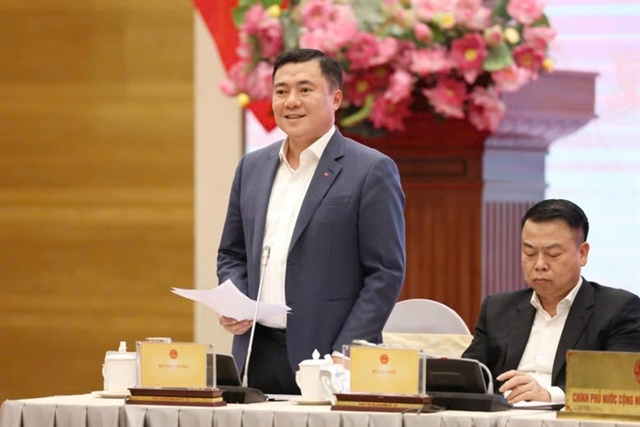
Deputy Minister of Industry and Trade Nguyen Sinh Nhat Tan. Photo: VGP |
Recently, at the November regular government press conference, Deputy Minister of Industry and Trade Nguyen Sinh Nhat Tan analyzed the three most significant benefits of restarting the Ninh Thuan Nuclear Power Project.
First, nuclear power can provide a clean baseload power source, meeting the dual criteria of green and renewable energy development. Without a stable baseload power source to balance the rapid growth of renewable energy sources, it could be dangerous. Along with nuclear power, other energy forms will ensure energy security while promoting green energy development.
Second, the Ninh Thuan Nuclear Power Project, once operational, will contribute to providing a safe energy source for socio-economic development, not only for Ninh Thuan province but for the entire country. In the future, with the trend of green energy development, Vietnam can even aim to export energy.
Third, nuclear power will create momentum for Vietnam to advance towards high technology, especially atomic technology, along with the development of supporting industries and high-quality human resources.
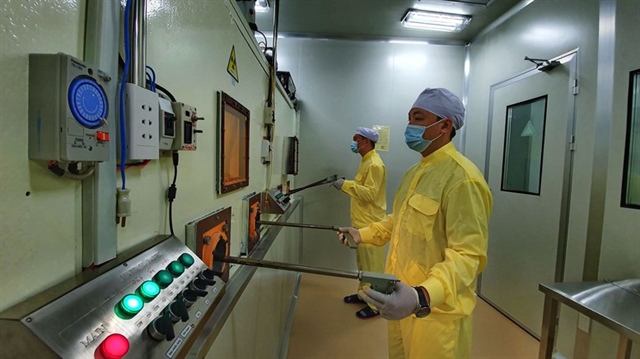
Production line 2 for I-131 solution at the Isotope Center, Da Lat Nuclear Research Institute |
Opportunity for a Technological Leap
In Southeast Asia, over the past 40 years, research and development in nuclear energy have gone through various phases. Still, the region has yet to see an operational nuclear power plant. This fact highlights the significant challenges in nuclear science and technology for each country.
Thus, restarting the Ninh Thuan Nuclear Power Project will not only address energy issues but also open up development opportunities for domestic science and technology. Dr. Tran Chi Thanh, Director of the Vietnam Atomic Energy Institute (VAEI) under the Ministry of Science and Technology (MOST), stated, “The project will greatly motivate the nuclear science sector.”
Consequently, restarting nuclear power development will require building a team of experts in fields such as nuclear physics, reactor engineering, radioactive waste management, and nuclear safety. This will stimulate universities and research institutes to invest more vigorously in related education and research.
Nuclear power projects will foster international cooperation, allowing Vietnam to access modern technologies from countries with advanced nuclear science, such as Russia, Japan, or France.
Moreover, nuclear power demands high standards of safety and risk management, compelling Vietnam to invest in modern management and monitoring systems. This will enhance technology management capabilities on a large scale. The technical infrastructure for nuclear power, such as transmission systems and waste treatment, will drive the modernization of the entire industry.
It is evident that restarting the Ninh Thuan Nuclear Power Project is not just about solving the energy equation but also about providing Vietnam with the opportunity to develop high-quality human resources and participate in the global nuclear power supply chain. However, a prerequisite is a meticulous implementation plan that ensures safety, efficiency, and sustainability.
(To be continued)
Phan Trang Thu Giang
– 20:24 27/12/2024
“Cà Mau’s Ambitious Vision: Targeting 5,000MW of Renewable Energy Exports by 2040”
The Ca Mau Provincial Government has set its sights on an ambitious renewable energy future, with plans to export a substantial amount of power generated from renewable sources. By 2031, the province aims to export 2,000MW of electricity, with this figure set to increase to 3,000MW by 2035 and an impressive 5,000MW by 2040. This forward-thinking strategy positions Ca Mau as a leader in sustainable energy development, paving the way for a greener and more resilient future.
Unveiling the Demand for Nuclear Power Talent: A Thousand-Strong Workforce Needed
Deploying the two nuclear power plant projects, Ninh Thuan 1 and Ninh Thuan 2, will require a substantial workforce of 2,400 skilled individuals. This ambitious endeavor demands a dedicated and highly trained team to ensure its successful operation. With a workforce of this magnitude, the projects will undoubtedly have a significant impact on the local community and economy.
Sure, I can help you with that!
Title: CEBR: Vietnam Could Have Joined the High-Income Countries Group
The CEBR estimates that Vietnam’s per capita GDP in 2024 will reach $4,469. With this projection, Vietnam would ascend into the upper-middle-income country category, a testament to its remarkable economic progress.



















